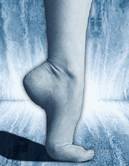
WEDNESDAY, Aug. 21 (HealthDay News) — Your feet may be less unique and evolved than once thought: A new study suggests that the mechanisms of human feet have much in common with those of great apes.
Current understanding of the evolution of human feet dates back to research from the 1930s. It concluded that people’s feet work quite differently from those of their primate “cousins,” due to the arches in the mid-region of human feet and the presumed rigidity of their outside edge.
But that theory was tripped up by U.K. researchers who analyzed more than 25,000 steps made by people on a pressure-sensitive treadmill. They found that human feet still have a surprising amount of flexibility, similar to that in the feet of great apes such as chimpanzees and orangutans.
“It has long been assumed that because we possess lateral and medial arches in our feet — the lateral one supposedly being rigid and supported in bone — that our feet differ markedly to those of our nearest relatives, whose mid-foot is fully flexible and makes regular ground contact,” Robin Crompton, of the Institute of Ageing and Chronic Disease at the University of Liverpool, said in a university news release.
“This supposed ‘uniqueness,’ however, has never been quantitatively tested,” he said. “We found that the range of pressures exerted under the human mid-foot, and thus the internal mechanisms that drive them, were highly variable, so much so that they actually overlapped with those made by the great apes.”
The researchers added that it was previously believed that it was mostly people with diabetes or arthritis whose mid-foot region makes contact with the ground. Both conditions can affect the structure of the foot.
But the results from the pressure-sensitive treadmill showed that two-thirds of healthy people produced some footfalls where the mid-foot touched the surface, something that seems to be a part of normal healthy walking, the researchers said.
The study appeared Aug. 20 in the journal Proceedings of the Royal Society B.
“Our ancestors probably first developed flexibility in their feet when they were primarily tree-dwelling, and moving on bendy branches, but as time passed and we became more and more ground-dwelling animals, some new features evolved to enable us to move quickly on the ground,” Dr. Karl Bates, also with the Institute of Ageing and Chronic Disease, said in the news release.
“We hypothesize that despite becoming nearly exclusively ground dwelling, we have retained flexibility in the feet to allow us to cope effectively with the differences in hard and soft ground surfaces which we encounter in long distance walking and running. The next part of our study will be testing this theory, which could offer a reason why humans can outrun a horse, for example, over long distances on irregular terrain.”
More information
The American Orthopaedic Foot and Ankle Society outlines ways to keep your feet flexible.
Copyright © 2025 HealthDay. All rights reserved.

